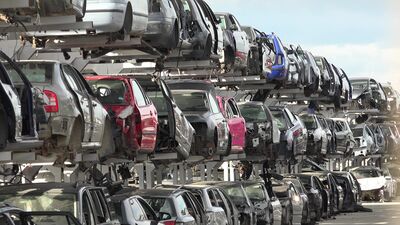On the road to recycling : How car recycling is driving sustainability forward

Cars are not only a means of transport. Ever since German inventor Carl Benz filed a patent application for his first motorised car back in 1886, automobiles have also stood for inventiveness, freedom and adventure. There are literally hundreds of songs written about cars and driving. From the Beatles’ “Drive my car” to Tracy Chapman’s “Fast Car”, from Willie Nelson’s “On the Road Again” to Snow Patrol’s “Chasing Cars”. Austrian singer-songwriter Rainhard Fendrich even wrote a heartfelt ballad about a beloved car lost due to a car crash.
Our modern society would not be like it is without the invention of the automobile. But nothing lasts forever, and so even the sturdiest vehicle will come to the end of its life. That’s when it becomes the problem of car recyclers, whose job it is to ensure that the road to mobility doesn’t turn into a highway to hell.
Related article: EV Battery Recycling: Baby, I can recycle your car!
Cars everywhere
The human love for cars is not just something felt or evoked in songs ‒ there are solid statistics underlining the sentiment. According to a Statista survey from March 2023, 75 per cent of the US population said they had access to their own car, with a further 20 per cent having access to a company or family car. Light trucks remain the most popular vehicle type in the US and, together with cars, accounted for sales of approximately 15.5 million in 2023. Only 3.12 million of the vehicles sold were cars, by the way.
In the EU, the number of registered passenger cars reached almost 257 million in 2023, corresponding to an increase of 6.7 per cent compared with 2018.
Among the EU countries with the highest motorisation rates, i.e. passenger cars per thousand inhabitants, there are a few smaller countries (see Figure 1). Italy tops the list with 694 cars per thousand inhabitants, followed by Luxembourg with 675 cars per thousand inhabitants.
Related article: "The future of car recycling will rely on advanced technology and automation to manage increasingly complex vehicles"
One significant change in car sales can be observed. The number of battery-only electric passenger cars is increasing steadily. Between the end of 2022 and the end of 2023, it surged by 49 per cent to reach almost 4.5 million vehicles, according to Eurostat. (see Figure 2)
Related article: "We will have to wait a few more years to see a solid system in place when it comes to plastics recovery in the automotive sector"
Coming to an end
In the US, approximately 6 per cent of the total vehicle population enters the recycling infrastructure each year. In the EU, the total number of end-of-life vehicles (ELV) was estimated at 5.7 million in 2021, an increase of 5.7 per cent compared with 2020. (see Figure 3)
Related article: "Car recyclers increase their focus on scrap quality and pre-shred preparation"
The EU saw the necessity to actually recycle cars, that is, to recover parts for reuse and materials for recycling, back in 2000 when the Directive on ELV entered into force. More than 20 years later, in July 2023, the European Commission presented a proposal for an ELV Regulation. The proposal will be considered by the European Parliament and the Council.
The thing is: Vehicle production is one of the most resource-intensive industries. In the EU, the automotive sector is the largest consumer of several key materials, using 42 per cent of aluminium, 44 per cent of magnesium, 63 per cent of platinum group metals, 67 per cent of natural rubber, and 30 per cent of rare earth elements by 2025, with demand continuing to grow rapidly. Since the majority of these materials are not readily available within the EU, they need to be imported. Cars are not designed for recycling, so even if they enter the recycling infrastructure, it is difficult to recover all materials. Besides the loss of resources, pollution caused by not properly handling ELVs is a big problem.
Furthermore, over 800,000 used cars are exported from the EU each year, the majority of them to Africa. Many of these vehicles are highly polluting and dangerous (causing road deaths) due to their age. The export of ELV is already banned but needs better enforcement. Too many vehicles just disappear from European roads.
The proposed regulation now aims to promote the sustainable management of ELVs. These rules focus on eliminating hazardous substances from cars and ensuring that the majority of ELV parts and materials are reused or recycled. The initiative advocates for enhanced collection, treatment and recycling processes for ELVs, aligning with the European Green Deal's goals by encouraging the car industry to adopt a more sustainable approach to vehicle design and production. In short, the new regulation covers the whole life cycle of a vehicle.
“The automotive industry plays an important role in accelerating the transition to the circular economy. Building on the life-cycle approach that we agreed for batteries, we are proposing rules to make vehicles circular by design and to ensure that at the end of their life, vehicles are a source of valuable spare parts, critical raw materials and other key resources such as high-quality recycled plastic and steel. This new approach will make the European vehicle industry more sustainable and resilient, reduce dependence on primary raw materials and energy, boost EU’s recycling sector and enhance the markets for used spare parts and secondary materials,” said Virginijus Sinkevičius, Commissioner for Environment, Oceans and Fisheries as the proposal was presented. (see Figure 4)
The recycling industry is getting ready
Be it the introduction of new rules and regulations, changes in the market or customer demands: The recycling industry is getting ready to face every challenge and change that comes its way.
“In recent years we have seen increased awareness of the quality of scrap available on the market and the importance of its availability to produce high-quality end products whilst reducing the use of raw materials such as Pig Iron and DRI,” says James White, Recycling Product Manager at Eriez Magnetics Europe. “I believe that car recyclers are becoming more conscious of the effect that good quality pre-shred sorting, preparation and disassembly has on the scrap that is produced. The reduction of contaminants such as copper and chrome is becoming increasingly important.” Even though it remains quite unclear what purity or quality of scrap will be required by the mills, there is certainly an awareness that quality will be more closely monitored in the near future as mills move away from the traditional BOFs (Basic Oxygen Furnace) and switch over to EAFs (Electric Arc Furnace). “The driving force for some emerging markets is the decarbonisation of the steel industry and net zero 2050,” White adds. “BOFs use more raw materials, which are less sustainable, whereas EAFs can tolerate a lot more scrap metals, which help to provide a circular economy in steel production. If we can optimise the quality of steel scrap (i.e. reducing impurities such as copper), we can use more scrap in the blend or mix of metals used to create new steel.”
But, as Luisa Macchion, Marketing Coordinator, FOR REC SPA, argues, the shift away from internal combustion engines means there will be less demand for certain types of metal recovery, such as steel from engine blocks. “As the market for electric vehicles grows, recyclers will need to invest in new technologies and processes to handle these unique components, ensuring that the industry remains profitable and sustainable.”
Going electric
The global move towards electric vehicles (EV) is in general a huge topic for the recycling industry. “It is forcing car recyclers to totally rethink their recycling strategy and processes,” says Tom Higginbottom, Technical Sales Engineer at Bunting. “This is changing the way in which car recyclers operate and will require significant investment in new equipment and processes.”
Cars are getting ever more complex. Materials are becoming more diverse and exotic, as Henk Jan Nix, General Secretary of the European Group of Automotive Recycling Associations (EGARA), says. James White agrees: “New vehicles are incorporating new technologies containing increasing amounts of electrical components and circuit boards, as users demand functionality such as CarPlay/MirrorLink, etc. This will ultimately require the use of many different separation solutions to meet environmental targets.”
“The future of car recycling will likely involve more advanced technology and automation to handle the increasing complexity of vehicles,” says Luisa Macchion.
What about plastic?
While the majority of a car is made of metal, a good part is also made of plastic. Whereas the supply stream from post-consumer plastics collected from urban households is well established and reliable, it will take a few more years to see a solid system in place when it comes to plastics recovery in the automotive sector, as Leonardo Forner, Head of Sustainability at Sirmax Group explains. “Although some supply chains are already sourcing secondary raw materials, the main critical issues relate to the presence of very heterogeneous plastics, both because of their polymeric nature and because of their ageing, which has a very negative impact on performance, and finally the relative cost of dismantling. Undoubtedly, the eco-design measures taken by designers and the orientation towards homogeneous materials for the production of components will be key points in solving this type of problem.” But he argues that the current demand for recycled materials is completely misaligned with the potential demand because automotive projects have a very long lead time: “In this sector, extensive physical and mechanical testing is required to ensure that the recycled material passes all the tests it is subjected to, which in most cases are identical to those of the virgin component.”

Collaboration with car manufacturers
The car recycling industry is adamant that a close collaboration with automobile manufacturers is the best way to move forward. Especially to be able to reach sustainability targets. “There are inherent difficulties in recycling electric vehicles, far greater than traditional combustion engines. The electric car manufacturers need to work with the car recyclers on design and assembly to make recycling as simple and as cost-effective as possible,” says Tom Higginbottom.
Many companies already collaborate with the car industry: “Steinert is part of the #Car2Car initiative, working towards a more sustainable future in automotive recycling alongside other key partners like BMW, thyssenkrupp and TU München,” says Marianne Grub, Marketing Manager at Steinert. “Collaborating with industry and science experts, we're developing innovative recycling processes to increase recovery rates for materials like aluminium, steel, glass, copper and plastic.”
New challenges ahead
The car recycling industry faces quite a few challenges. “One is the need for recyclers to stay compliant with ever-evolving environmental regulations while also meeting market demand for high-quality recycled materials,” says Luisa Macchion. “Additionally, the volatility of commodity prices can impact the profitability of recycling operations, putting pressure on businesses to maximise recovery rates and reduce waste.”
And Henk Jan Nix adds: “To be able to meet the targets of the ELV Regulation, car recyclers will have to remove and store materials for which no collectors or recyclers currently exist and which will be unprofitable for some time at least.”






